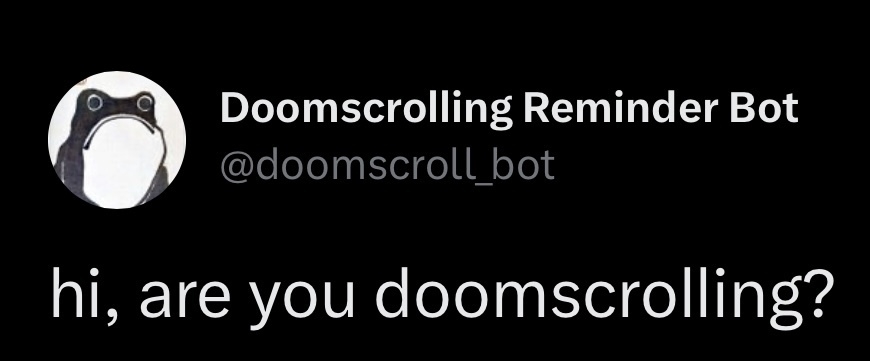
Twitter. Oh how I could stroll that infinite corridor of information.
Ever since having kids my personal time has been squeezed into a tiny ball. Still, I’d finish putting the kids to bed, open my phone, and where would I end up? On Twitter for 45 minutes. An hour. Hour 30. I’d sit there feeding whatever meager morsels of free time I had left to that tiny blue bird, it gobbling them up like some kind of attention soaked black oil sunflower seeds1.
Twitter was my go to. I could certainly get lost on Instagram, or TikTok. But something about those platforms felt more wasteful. I wasn’t doing anything “worthwhile” there. Being on Twitter I could create warped justifications that I was actually learning things from people. Many times I was. But it was just as easy to get lost in pointless wanderings, sucked into controversy I didn’t care about 5 minutes earlier. And even when I learned something, was it best use of my time?
During one of these info dump excursions, I saw a tweet about an app called “one sec”. It got me curious - taking a deep breathe, delaying distracting apps… adding friction?
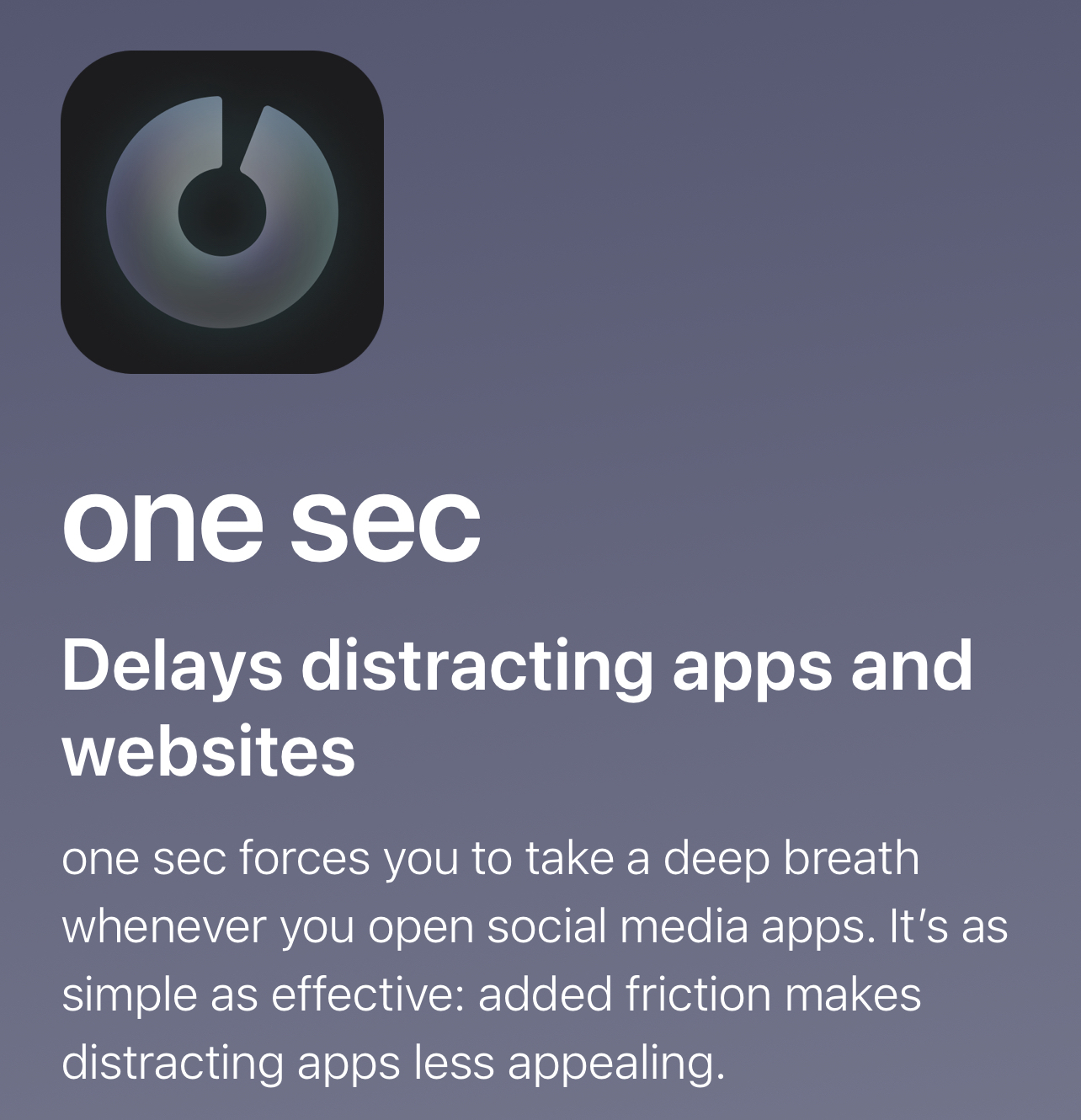
… isn’t that basically Screen Time?
It sounded interesting, but was it really any different from screen time limits?
I have had screen time limits on social media since that feature first released on iOS. At worst it is a minor annoyance that I hardly notice myself dismissing. At best it occasionally saves me after already wandering aimlessly for ages.
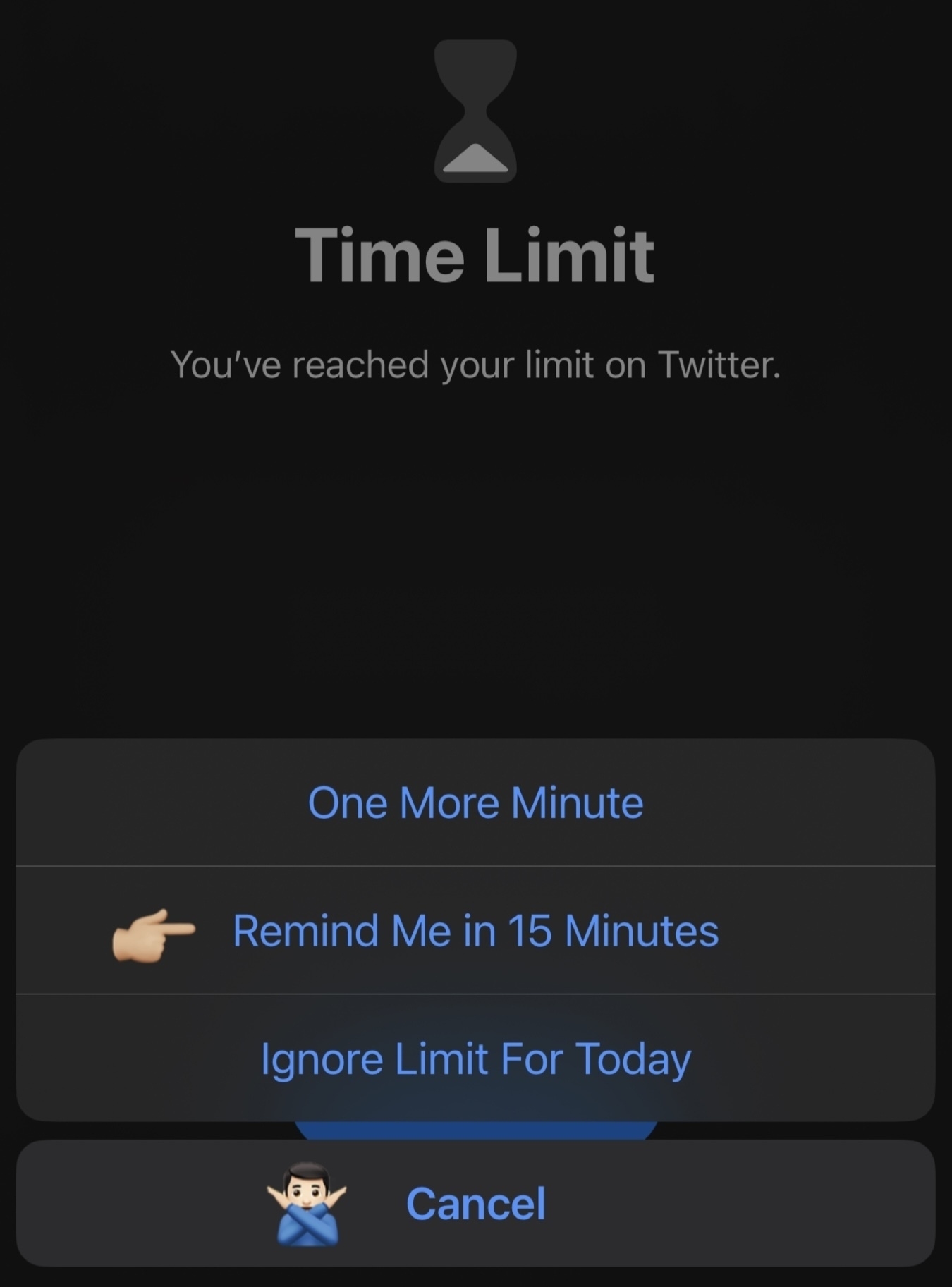
My rock solid screen time workflow:
- You’ve reached your limit!
- tap “Remind me in 15 minutes”
- You’ve reached your limit!
- tap for 15 more
- You’ve reached your limit!
- Ugh, I just want to finish reading one thing - I can probably do it in 1 minute?
- You’ve reached your limit!
- …give up and tap “Ignore limit for today”2
So what about “one sec” was going to make that any different?
The difference I found with “one sec” is specifically related to what they advertise: added friction. In full they describe it as “added friction makes distracting apps less appealing.”
Screen time does not make apps less appealing. Screen time is almost completely frictionless. How much friction does quickly tapping a screen cause? I’ve extended my screen time so many times over the years I probably could tap each option by muscle memory.
“One sec” is all friction. Here’s an example of what it’s Iike when you try to open an app connected to “one sec”:
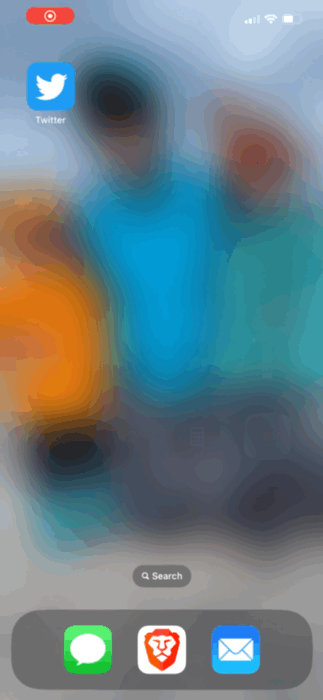
That’s actually sped up a bit - the default is a 6-10 second animation. See how you are forced to sit and wait? That waiting is the key. It’s the friction they describe. I literally cannot get into that app any faster, and then I still have to decide whether I move forward once I finish waiting.
You sit there for 10 seconds - it’s intentionally aggravating, and it forces you to question how committed you are to opening the app. Does it really matter to me?
Here’s my new workflow with “one sec”:
- Open app
- “One sec” pops open
- Take a deep breath. Wait for the screen to reveal my options
- Phew, still waiting
- This is only 10 seconds? Do I really want to open the app this badly?
- Ok, moment of truth. Close or continue on?
- Here I usually just drop out, but sometimes I “Continue to ‘app’”. Now I still have to make one more decision. What’s the reason I’m using it?
- Not worth it, I’m out 👋🏼

For the rare times I actually stick around, I love the intention prompt. If the initial friction of waiting isn’t enough, here is one more layer of confronting my habit. You have a base set of intentions, and I’ve created a custom prompt for the one thing I ever do anymore on Instagram.
I don’t remember if this was on by default, but if it isn’t you should absolutely enable it through “Intention Tracking”

Is there anything more to it than friction?
Why would friction be so much more effective than screen time limits? Why would it be more powerful than just willing yourself to leave social media?
This excerpt from James Clear’s “Atomic Habits” sums it up really well:
Your environment is more important than your willpower
It is important to remember that the environment drives our good behaviors as well as our bad ones. People who seem to stick to good habits with ease are often benefitting from an environment that makes those behaviors easier.
Atomic Habits - Chapter 12
“One sec” changes your environment. Your typical phone environment is every app instantly available with a tap. With “one sec”, you are forced to evaluate that tap instead of mindlessly hopping around.
“One sec” has also been analyzed in two different academic studies about its impact on social media usage:
Social media usage cut in half through “one sec” intervention3
Friction causes behavioral change
By taking out the instant gratification, the urge for unintentional social media usage fades away over time: user’s brain now connects opening Instagram with something unpleasant, having to wait 10 seconds during the breathing intervention.
The takeaway: instant gratification (tap in and space out) is replaced with an unpleasant experience (waiting and being forced to acknowledge your own motivators). You are actually re-wiring your brain through this change. I can attest to that - the thought of opening apps and waiting through the “one sec” interstitial is pretty unpleasant, and stops me before I even consider opening them.
How do I use it?
For such a powerful app, the setup is a bit clunky.
As far as I can tell this isn’t “one sec”s fault - it’s likely not possible to block one app with another app just by having it installed. If it was, you could completely block a persons phone by convincing them to download your app.
To enable “one sec” you need the one sec app and the Shortcuts app. You create a personal automation that triggers “one sec” any time you go to open a specific application.
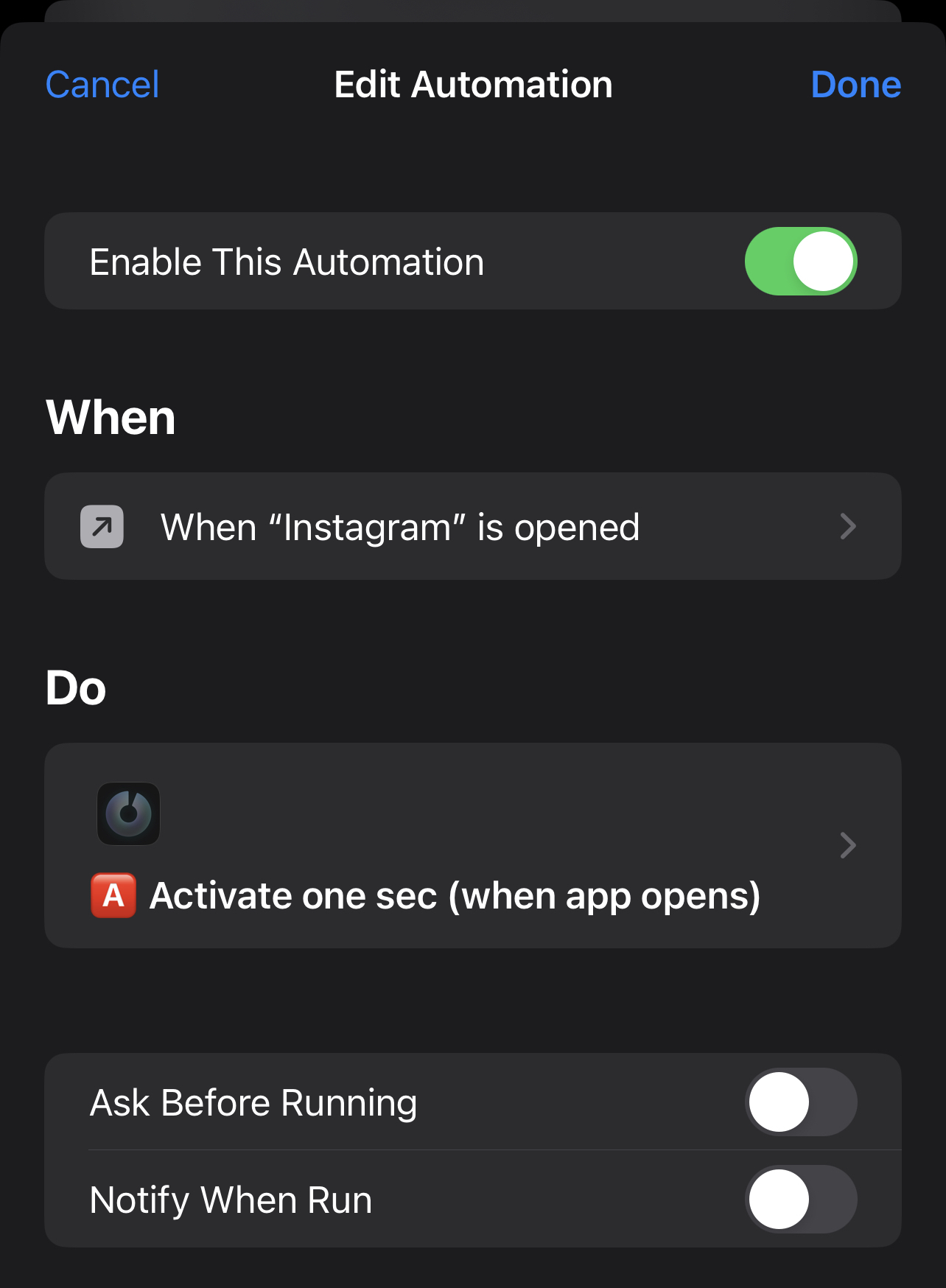
As of writing this I’m up to 8 automations connecting to “one sec”:
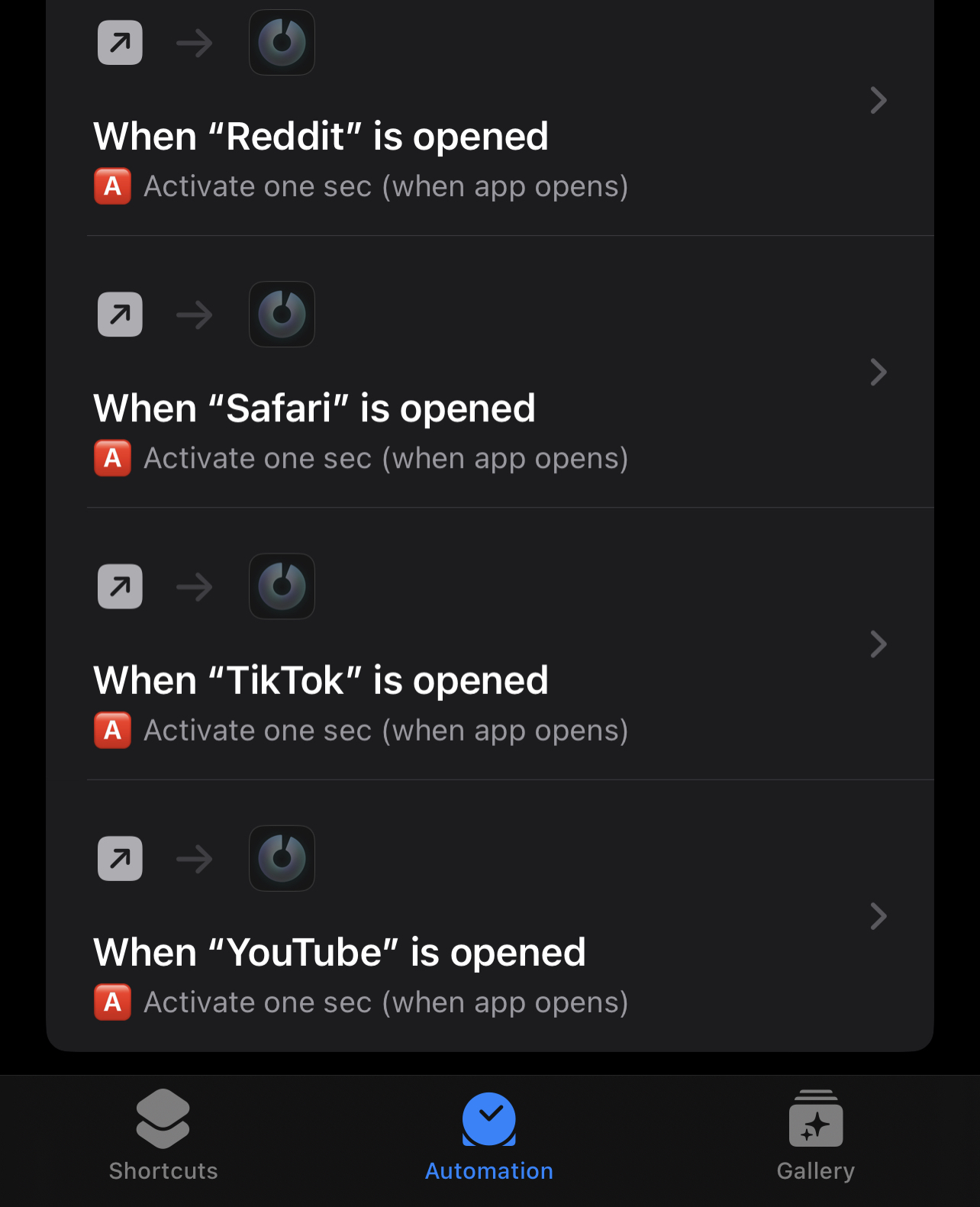
The biggest benefit you’ll get out of it is by using the “pro” version, which currently costs me about $16/yr. It’s absolutely worth it, but you can also use the free version to try out the behavior against a single app and see how you like it.
“One sec” displays the number of times it’s prevented you from opening each app, and estimates time saved. It’s interesting to analyze preventions, though it’s saved me way more time than it takes credit for.
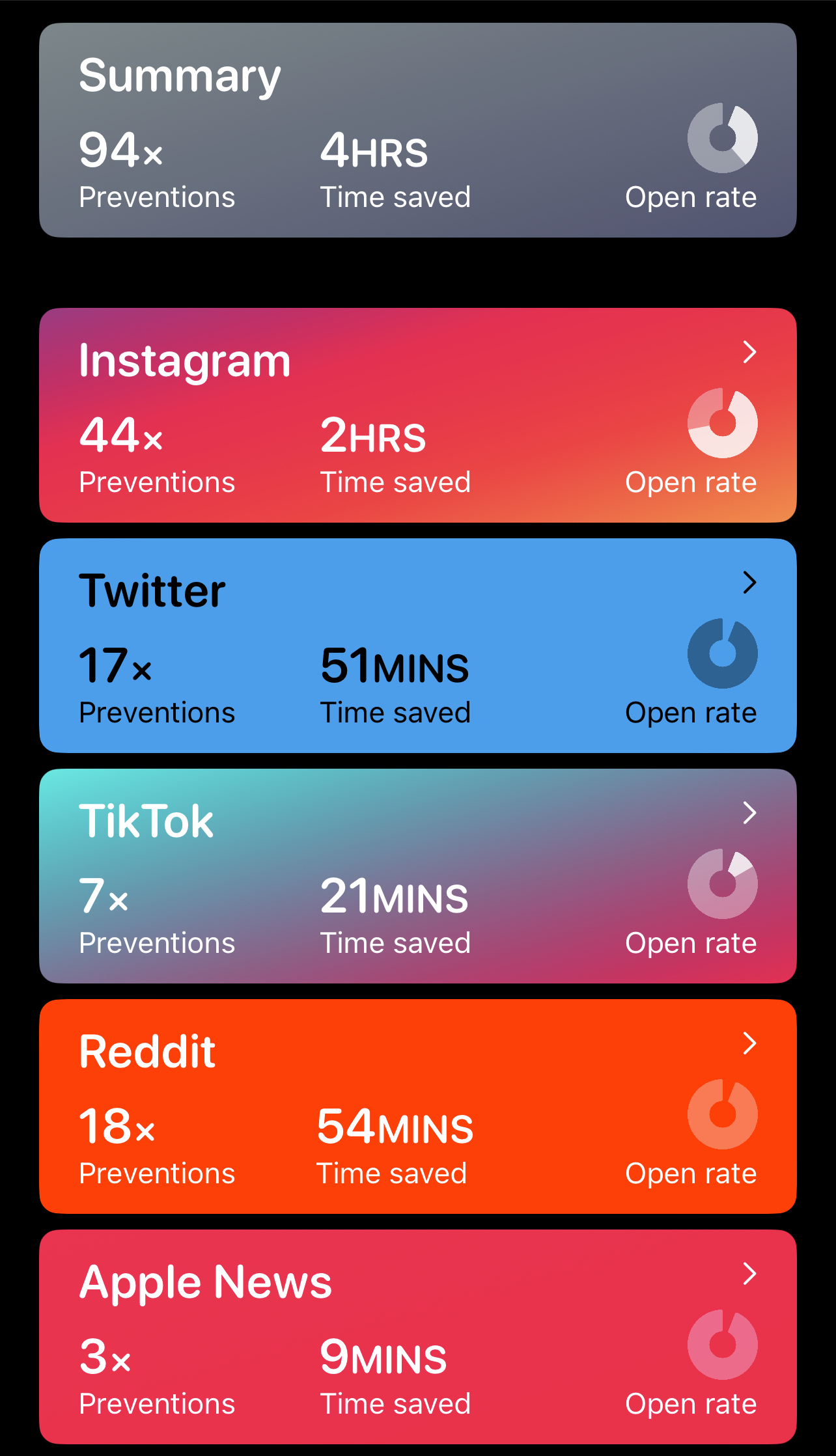
The one sec site has great documentation, and the app offers videos on setup, so you can read and watch those once you download it.
What I’ve been doing instead
The clearest change for me is that I’m even writing this. It’s been years since I’ve written anything, and I’ve invested some of my time into a new writing workflow.
As well I’ve been learning a new programming language, reading books, exercising, and just generally formulating uses of my time that align with my values.
Social media, even when not all consuming, is a time suck. You probably have alternatives that would make you happier if only you left these platforms4.
Oh and I’ve been sleeping better. I have less options to distract me if I wake up at night - it’s a beautiful thing.
Throwing the baby out with the bath water5
Social media may be a huge time suck, but it’s not 100% useless. I think most people find some slices of learning, inspiration and connection on it somewhere.
For me, Twitter was often a valuable learning resource. It was a useful tool for keeping up with technology trends that matter to me personally and professionally. Unfortunately, I can’t disentangle the good (learning) from the bad (aimless wandering). Social media is designed to suck us in and keep us there as long as possible - I can’t fight that programming, I can only avoid it.
As a way to keep up with folks I follow without using Twitter directly, I’ve been using Mailbrew. It allows me to setup a digest based on my timeline and I can also choose specific Twitter handles to keep up with. It doesn’t recreate the experience of spontaneous discovery, but that means it also doesn’t trigger the accompanying variable ratio schedule6 with it.
Going even deeper with “one sec”
In writing about “one sec”, I’ve dug into the app quite a bit. I’ve found that “one sec” is deeply configurable and filled with additional features. Blocking apps was my main draw but it has a variety of other features including:
- Blocking websites with a safari extension
- Hooking into focus modes to completely block apps during those times
- Starting a “block session” in the app which blocks every app and website you have configured
- Triggering “don’t get lost” notifications if you’ve gone through to an app and have been there for awhile
“One sec” can do even more and I’ve found myself expanding not only what it enables but also what apps I apply it to. I now have periods where I apply “one sec” to email, slack and web browsers. I have my sleep focus setup to completely block them so I can’t wake up in the middle of the night and just hop over to bad habits.
It’s starting to feel like a distraction reducing superpower.
Next steps
Eventually, having subjected all apps on my phone to triggering “one sec”, I will finally setup “one sec” to trigger “one sec” whenever it opens. This will likely initiate an infinite loop that causes my phone to melt completely7.
In this highly probable scenario, maybe I’ll just switch back to a flip phone?
More likely I’ll buy a smartphone again… but I know the first app I install will be “one sec”.
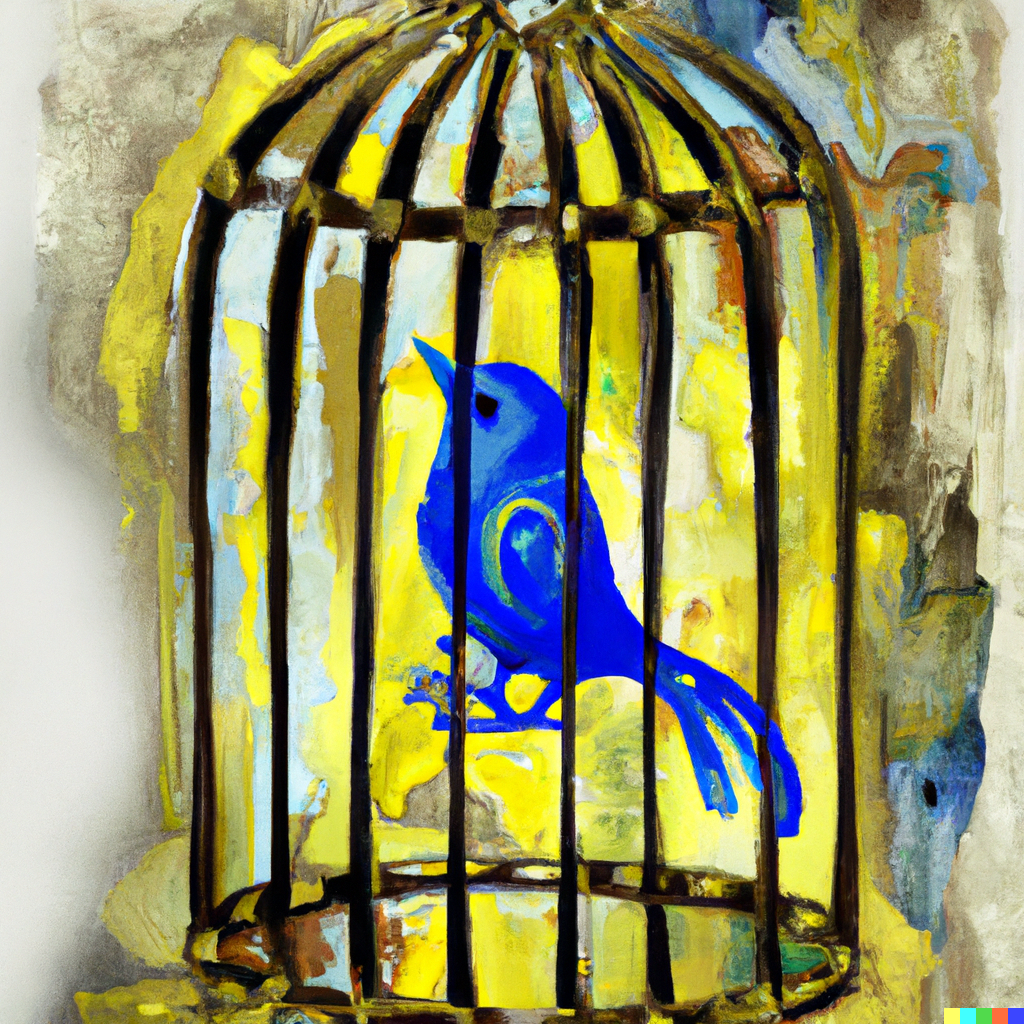
-
I suppose I’m being presumptuous in assuming the Twitter bird likes black oil sunflower seeds. The birds in my yard go wild for the stuff, so seems like a strong likelihood ↩︎
-
I do wonder if screen limits are even meant to_actually_ stop you, or just check off a box on device usability for Apple. All screen time tracking usually does is make you think “wow.. I use this phone too much”. There’s no behavior change. Information in isolation does not change behavior.
This is a bit like mandates to make it clearer to consumers what the nutrition facts are for different foods so people can make “informed decisions”. This helps some people do that, but for most people it’s meaningless information that they completely ignore (or notice, but eat/drink it anyways and just feel bad about it later).
It’s highly anecdotal but I’ve never met anyone who found screen limits to be helpful. ↩︎
-
This is from the “one sec” blog, which is a good read in general.
Honestly some of their blog post illustrations are fantastic - much nicer than I expected such a utilitarian app to have. The referenced post in particular looks great, so here it is again https://one-sec.app/max-planck-study/ ↩︎
-
If not, then get your social media on! Who am I to judge if it makes you genuinely happy? ↩︎
-
The sentiment is right, but figures of speech are so weird. Also I like to think no one has ever actually done this 😰 ↩︎
-
https://rationalwiki.org/wiki/Variable_ratio
I think this tracks. Essentially using Twitter for me is like using a slot machine. I get hits of value, but on a variable schedule. Because I don’t know when the next hit will occur, but I know it probably will, I keep going indefinitely. ↩︎
-
I am genuinely curious whether it’s possible and if apple or the “one sec” developer have handled it but I’m too scared to try it 😅 I know my phone won’t melt, but could I crash it? ↩︎